ORACLE 12c新特性 可插拔
- 格式:doc
- 大小:557.58 KB
- 文档页数:16
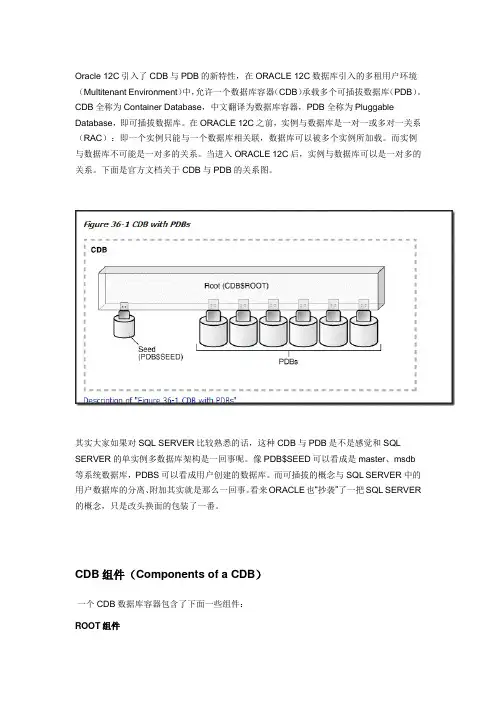
Oracle 12C引入了CDB与PDB的新特性,在ORACLE 12C数据库引入的多租用户环境(Multitenant Environment)中,允许一个数据库容器(CDB)承载多个可插拔数据库(PDB)。
CDB全称为Container Database,中文翻译为数据库容器,PDB全称为Pluggable Database,即可插拔数据库。
在ORACLE 12C之前,实例与数据库是一对一或多对一关系(RAC):即一个实例只能与一个数据库相关联,数据库可以被多个实例所加载。
而实例与数据库不可能是一对多的关系。
当进入ORACLE 12C后,实例与数据库可以是一对多的关系。
下面是官方文档关于CDB与PDB的关系图。
其实大家如果对SQL SERVER比较熟悉的话,这种CDB与PDB是不是感觉和SQL SERVER的单实例多数据库架构是一回事呢。
像PDB$SEED可以看成是master、msdb等系统数据库,PDBS可以看成用户创建的数据库。
而可插拔的概念与SQL SERVER中的用户数据库的分离、附加其实就是那么一回事。
看来ORACLE也“抄袭”了一把SQL SERVER 的概念,只是改头换面的包装了一番。
CDB组件(Components of a CDB)一个CDB数据库容器包含了下面一些组件:ROOT组件ROOT又叫CDB$ROOT, 存储着ORACLE提供的元数据和Common User,元数据的一个例子是ORACLE提供的PL/SQL包的源代码,Common User 是指在每个容器中都存在的用户。
SEED组件Seed又叫PDB$SEED,这个是你创建PDBS数据库的模板,你不能在Seed中添加或修改一个对象。
一个CDB中有且只能有一个Seed. 这个感念,个人感觉非常类似SQL SERVER中的model数据库。
PDBSCDB中可以有一个或多个PDBS,PDBS向后兼容,可以像以前在数据库中那样操作PDBS,这里指大多数常规操作。

oracle12c的CDB与PDBoracle12c的CDB与PDBoracle12c的新特性Oracle 12C引⼊了CDB与PDB的新特性,在ORACLE 12C数据库引⼊的多租⽤户环境(Multitenant Environment)中,允许⼀个数据库容器(CDB)承载多个可插拔数据库(PDB)。
CDB全称为Container Database,中⽂翻译为数据库容器,PDB全称为Pluggable Database,即可插拔数据库。
在ORACLE 12C之前,实例与数据库是⼀对⼀或多对⼀关系(RAC):即⼀个实例只能与⼀个数据库相关联,数据库可以被多个实例所加载。
⽽实例与数据库不可能是⼀对多的关系。
当进⼊ORACLE 12C后,实例与数据库可以是⼀对多的关系。
下⾯是官⽅⽂档关于CDB与PDB的关系图。
cdb相当于操作系统,调⽤并管理各个pdb。
pdb相当于真正提供业务需求的数据库实例。
oracle 12c安装后只创建了cdb,需要⾃⼰⽣成相应的pdb。
oracle 12c使⽤了CDB-PDB架构,类似于docker,在container-db内可以加载多个pluggable-db.安装成功后修改tnsnames.ora我的在D:\app\oracle\product\12.1.0\dbhome_1\NETWORK\ADMIN⽂件夹下############################tnsnames.ora#######################cdborcl =(DESCRIPTION =(ADDRESS_LIST =(ADDRESS = (PROTOCOL = TCP)(HOST = localhost)(PORT = 1521)) )(CONNECT_DATA =(SERVICE_NAME = orcl) #cdb的db_name))#pdbpdborcl =(DESCRIPTION =(ADDRESS_LIST =(ADDRESS = (PROTOCOL = TCP)(HOST = localhost)(PORT = 1521)))(CONNECT_DATA =(SERVICE_NAME = pdborcl) #pdb的db_name))##########################tnsnames.ora######################数据库下拉框会出现pdborcl选项遇到的坑使⽤system登录,PLSQL Developer选择ORCL,执⾏select name,open_mode from v$pdbs; ⽤来查看当前CDB容器中包含的PDB容器pdborcl的open_mide的状态是READ WRITE,使⽤pdborcl也能登录,但是你重启服务器这个状态会变为这时候PLSQL Developer选择pdborcl就不能登录了,出现错误因为服务器重启时,pdb默认不启动PLSQL Developer选择ORCL. system登录(或使⽤sqlplus)执⾏alter pluggable database PDBORCL open; 启动pdb创建⽤户创建新⽤户,注意CDB容器中创建⼀个通⽤⽤户,⽤户名必须以C##或者c##开头,因为CDB中默认创建的是common user如果想要创建本地⽤户,则要在PDB容器中创建,下⾯会说如何切换到PDB容器create user C##test identified by 123456; //其中C##test为⽤户名,123456为密码给新⽤户授权grant create session to C##test;grant create table to C##test;grant create tablespace to C##test;grant create view to C##test;切换⾄查到的某个PDB容器(上⾯查到的是PDBORCL)注意使⽤这个命令需要的sysdba级别的权限,否则⽆法执⾏,切换后才可使⽤当前pdb的私有⽤户进⾏操作,12c数据库创建完成后,默认情况下使⽤sqlplus / as sysdba 登录连接的是CDB。
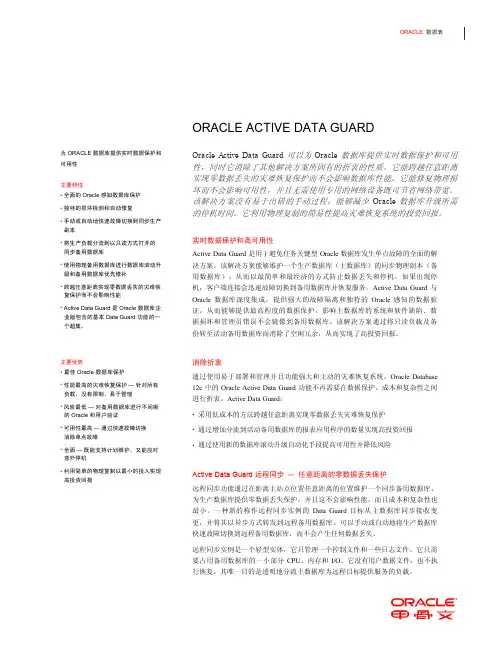
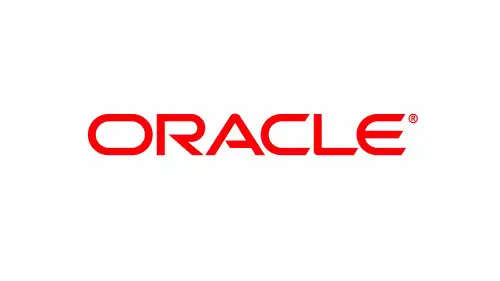
Top Oracle Database 12cHigh Availability Innovations A Technical DrilldownWei Hu, Vice President of Development, High Availability Technologies, OracleBest Innovations Make Things Easy▪Any sufficiently advanced technology is indistinguishable from magic - Arthur C. Clarke▪Any technology that is distinguishable from magic is not sufficiently advanced - Gregory Benford▪This talk will give an overview of the new high availability features introduced in Oracle Database 12c▪Then describes some of the internal innovations that make these features powerful and easy to useOracle Database 12c▪Oracle Database 12c introduces significant new HA capabilities that–Drastically cut down planned and unplanned downtime –Eliminate compromises between HA and Performance –Tremendously boost operational productivity▪These take Availability to unprecedented new levels–Next-generation Maximum Availability Architecture (MAA) –Optimized for OracleExtreme AvailabilityOracle Maximum Availability ArchitectureActive Data Guard–Data Protection, DR–Query OffloadGoldenGate–Active-active –HeterogeneousRMAN, Oracle Secure Backup–Backup to tape / cloudActive ReplicaEdition-based Redefinition,Online Redefinition, Data Guard, GoldenGate– Minimal downtime maintenance, upgrades, migrationsRAC–Scalability –Server HAFlashback–Human error correctionProduction SiteApplication Continuity–Application HAGlobal Data Services–Service Failover / Load BalancingOracle Database 12cHigh Availability Key* New Features ▪Application Continuity▪Global Data Services▪Data Guard Enhancements▪RMAN Enhancements▪Flex ASM▪Other HA Enhancements▪GoldenGate Update▪MAA at PayPal▪ *Nearly a hundred new HA features in 12cDatabase outages can cause in-flightwork to be lost, leaving users and applications in-doubt -–User frustration –Cancelled work –Duplicate submissions –Rebooting mid-tiers –Developer painsPre-12c SituationIn-Flight Work: Dealing with OutagesApplication ServersDatabase ServersEnd User▪Replays in-flight work on recoverable errors▪Masks many hardware, software, network, storage errors and outages ▪Supports JDBC-Thin, Universal Connection Pool (UCP), WebLogic Server, 3rd Party Java apps/mid-tiers ▪RAC, RAC One, & Active Data Guard ▪Better end user experienceApplication ContinuityMasks unplanned/planned outages when successfulApplication ServersDatabase ServersEnd UserDatabase RequestReplayedApplication Continuity SubtletiesThe hardest part of replay is deciding when NOT to replay▪Application Continuity minimizes divergence by re-executing SQL at original SCN (when possible) and rebuilding original environment–Stops replay (and returns error) if replayed request returns different result than original (e.g., two users concurrently updating same row)▪Application Continuity does not attempt replay (and returns error) if –Error is not recoverable – e.g., constraint violation–DDLs such as SHUTDOWN ABORT, DROP TABLESPACE are executed–Request has been explicitly disabled for replay – e.g., disbursing money–Failure occurred too long ago – don’t automatically replay a request from yesterday ▪Application Continuity is safe; only replays incomplete requests – Will not pay for the same item twiceafter outagesTransaction GuardPreserve & Retrieve COMMIT Outcome▪Tracks outcome of the last transaction ▪Without Transaction Guard, retry can cause logical corruption▪Transaction Guard allows applications to deal correctly with failures▪Application Continuity uses Transaction Guard▪Transaction Guard also available for applications that do not use Application ContinuityApplication Continuity I nternalsOracle Database 12cHigh Availability Key New Features▪Application Continuity▪Global Data Services▪Data Guard Enhancements▪RMAN Enhancements▪Flex ASM▪Other HA Enhancements▪GoldenGate UpdateDatabases in Replicated EnvironmentsChallenges▪Maximum Availability ArchitectureActive Data Guard and GoldenGate with RAC▪Want to optimize utilization ofActive Data Guard and GoldenGate databases–Efficiently use all availabledatabases–Automated load balancing and faulttolerancePrimary Active Standby Active StandbyGlobal Data Services•Extends RAC-style service failover, loadbalancing (within and across datacenters), and management capabilities to a set of replicated databases•Takes into account network latency,replication lag, and service placement policies•Achieve higher availability, improvedmanageability and maximize performanceLoad Balancing and Service Failover for Replicated Databases▪Reporting client routed to ‘best’ database–Based on location, response time, data, acceptabledata lag–Reports will automatically run on least loaded server▪Reporting client failover–If preferred database not available, will route toanother database in same region or a remote database▪Global service migration–Automatically migrates services based onfailover/switchover - if primary database is down, start Call Center service on the new primaryActive Data Guard ExampleActive Data GuardReporting ServiceCall Center Service▪Call Center Client connections andrequests transparently routed to the closest / best database–Runtime load balancing metrics give client real-timeinformation on which database to issue next request▪If a database fails, its global services arerestarted on another replicaGoldenGate ExampleGoldenGateCall Center ServiceLoad Balancing is Very ComplicatedGlobal Data Service (GDS) Load Balancing▪Supports connect-time and run-time (per-request) load balancing▪Load balancing is easy if all your machines and workload are uniform–GDS supports heterogeneous environment – RAC + non-RAC, powerful and less powerful machines (important since some customers have less powerful machines for DR)▪Load balancing is NOT equal load on all machines–Instead, GDS minimizes average response time across all requests–If database 1 much faster than database 2, then 100% of requests might go to machine database 1–Sometimes, request to lightly-loaded database in remote region might complete faster than request to heavily loaded database in local region–Equalization of average response time done for all clients in each region (remote requests expected to be longer) ▪Load balancing must balance responding rapidly to changing workloads and avoiding oscillations▪Uses internal database metrics, does not blindly rely on external metrics–More accurate (factors out network variability), handles workload generated external to global services, & handles planned shutdown caseGlobal Data Services: SummaryGlobally Replicated, High Availability Architecture••• GSM - Global Service ManagerLocal StandbyLocal StandbyData Center #2 EMEAAPACGuardData GuardPrimaryLocal StandbyActiveData GuardGDSCTLGDS Catalog PrimaryGDS Catalog StandbyMasterOracleGoldenGate Active GuardSALES POOL (sales_reporting_srvc, sales_entry_srvc)HR POOL(hr_apac_srvc, hr_emea_srvc)All GDS client databases connected to all GSMsMasterRemote StandbyReader FarmActive Data GuardGlobal Service ManagersGlobal Service ManagersOracle Database 12cHigh Availability Key New Features▪Application Continuity▪Global Data Services▪Data Guard Enhancements▪RMAN Enhancements▪Flex ASM▪Other HA Enhancements▪GoldenGate UpdateZero Data Loss ChallengeThe longer the distance, the larger the performance impactSynchronous Communication Leads To Performance Trade-OffsPrimaryStandbyCommitCommit AckNetwork SendNetwork AckStandbyData Guard Async – TodaySome Data Loss Exposure Upon DisasterZero Data Loss For Async Deployments▪Far Sync: light-weight Oracle instance: standby control file, standby redo logs, archived redo logs, no data files▪Receives redo synchronously from primary, forwards redo asynchronously in real-time to standby▪Upon Failover: Async standby transparently obtains last committed redo from Far Sync and applies: zero data loss failover▪Second Far Sync Instance can be pre-configured to transmit in reverse direction after failover/switchover▪Terminal standbys required to be Active Data Guard StandbysPrimaryStandbyFar SyncInstanceStandbyFar SyncInstanceActive Data Guard Far SyncMuch work done to make things work ‘like magic’▪Looks just like SYNC. So Fast Start Failover (FSFO) works – automatic, zero data loss failover to far destination▪If Far Sync instance fails, can failover to another Far Sync (recommended), or go into async mode directly to standby (using remote alternate log_archive_dest_x)▪Sophisticated logic to make failovers seamless–When primary dies, Far Sync keeps track of state of async connections to terminal standby to ship the exact redo needed for zero data loss–Works with RAC (multiple threads of redo)▪Smart gap resolution – if the primary is missing redo, it can fetch from Far Sync instance. Far Sync instance will transparently fetch from primary & forward to standbyActive Data Guard Far SyncSummary of Benefits▪Best data protection, least performance impact▪Low cost and complexity▪Best way to implement a near DR + Far DR model▪Relevant to existing Data Guard ASYNC configurations▪Data Guard Failover? No Problem! Just do it – No Data Loss!Active Data Guard Real-Time CascadingEliminates Propagation DelayPrimary▪In 12.1, Standby 1 forwards redo to Standby 2 in real-time, as it isreceived: no propagation delay for a log switch▪Standby 2 (Active Data Guard Standby) is up-to-date for offloadingread-only queries and reports▪In 11.2, Standby 1 waits till log switch before forwarding redo fromarchived logs to Standby 2Data Guard Fast SyncReduced Primary Database Impact for Maximum AvailabilityLogsStandbyRedoLogsCommitCommitAcknowledge▪For SYNC transport: remote siteacknowledges received redo beforewriting it to standby redo logs▪Reduces latency of commit on primary▪Better DR – increased SYNC distance▪If network round-trip latency less thantime for local online redo log write,synchronous transport will not impactprimary database performance▪Can use Fast Sync from Primary to FarSync , and Fast Sync works with FSFO CommitCommitAcknowledgeAcknowledgereturned on receiptLogsStandbyRedoLogsData GuardOther New Features in Oracle Database 12cOracle Database 12cHigh Availability Key New Features▪Application Continuity▪Global Data Services▪Data Guard Enhancements▪RMAN Enhancements▪Flex ASM▪Other HA Enhancements▪GoldenGate UpdateFine-grained Table Recovery From Backup▪Simple RECOVER TABLE command torecover one or more tables (mostrecent or older version) from an RMANbackup▪Eliminates time and complexityassociated with manual restore, recover& export–Enables fine-grained point-in-timerecovery of individual tables instead ofthe contents of the entire tablespaceRMANBackupsCross-Platform Backup & Restore▪Simplifies procedure for platform migration▪Minimize read-only impact with multiple incremental backupsSimplified Platform MigrationSource Database (AIX)Backup to Disk/Tape (data files, optional endian conversion,metadata export)Restore Backup (optional endian conversion, metadata import)Destination Database (Solaris)▪Backup and recover specific pluggable databases with new PLUGGABLE DATABASE keywords:RMAN> BACKUP PLUGGABLE DATABASE <PDB1>, <PDB2>;▪Familiar BACKUP DATABASE command backs up CDB, including all PDBs ▪PDB Complete Recovery–RESTORE PLUGGABLE DATABASE <PDB>; –RECOVER PLUGGABLE DATABASE <PDB>;▪PDB Point-in-Time Recovery–RMAN> RUN {–SET UNTIL TIME 'SYSDATE-3'; –RESTORE PLUGGABLE DATABASE <PDB>; –RECOVER PLUGGABLE DATABASE <PDB>;–ALTER PLUGGABLE DATABASE <PDB> OPEN RESETLOGS; }▪Familiar RECOVER DATABASE command recovers CDB, including all PDBsPluggable Database Backup & RestoreFine-Grained Backup & Recovery to Support ConsolidationOracle Database 12cHigh Availability Key New Features▪Application Continuity▪Global Data Services▪Data Guard Enhancements▪RMAN Enhancements▪Flex ASM▪Other HA Enhancements▪GoldenGate UpdateAutomatic Storage Management (ASM) OverviewASM Cluster Pool of StorageDisk Group BDisk Group A Shared Disk GroupsWide File StripingOne to OneMapping of ASM Instances to ServersASM InstanceASM DiskRAC ClusterNode4Node3Node2Node1Node5ASMASM ASM ASMASMASM InstanceDatabase InstanceDB ADB A DB BDB BDB CDB BCurrent StateFlex ASM: Eliminate 1:1 Server MappingNew: ASM Storage Consolidation in Oracle Database 12cASM Cluster Pool of StorageDisk Group BDisk Group A Shared Disk GroupsWide File StripingDatabases share ASM instancesASM InstanceDatabase InstanceASM DiskRAC ClusterNode5Node4Node3Node2Node1Node5 runs as ASM Client to Node4Node1Node2 Node4Node2 runs as ASM Client to Node3 ASM ASM ASMASM InstanceDB ADB A DB BDB BDB CDB BFlex ASM: Supporting Oracle Database 11gPrevious Database Versions Will Host Local ASM InstanceASM Cluster Pool of StorageDisk Group BDisk Group A Shared Disk GroupsWide File StripingDatabases share ASM instancesASM InstanceDatabase InstanceASM DiskRAC ClusterNode5Node4Node3Node2Node1ASM ASM ASMDB ADB A DB BDB BDB C DB BASMASM11.2DB11.2DBOracle Database 12cHigh Availability Key New Features▪Application Continuity▪Global Data Services▪Data Guard Enhancements▪RMAN Enhancements▪Flex ASM▪Other HA Enhancements▪GoldenGate UpdateOther HA EnhancementsOracle Database 12cHigh Availability Key New Features▪Application Continuity▪Global Data Services▪Data Guard Enhancements▪RMAN Enhancements▪Flex ASM▪Other HA Enhancements▪GoldenGate UpdateNote: A single DR copy may be multi-purposed for any combination of the use cases describedData Guard Redo TransportSYNC or ASYNCOracle DatabaseOracle Active Data GuardReal-Time Data Protection and AvailabilityStandby First Patching, Exact copy of primary Query & Report OffloadOpen Read-Only Snapshot StandbyConvert to Test Database(open read-write)Single Command Refresh of primary Offload RMAN Backups of primary Far Sync, Database Backup Appliance, GoldenGateExact copy of primarySource for thin snaps/clones Exact copy of primary Extract offload, source for GoldenGate ALO modeOracle & Non-OracleMessage BusOracle Database12c *Oracle GoldenGate 12c*Low-Impact, Real-Time Data Integration & Transactional ReplicationData IntegratorNew DB/ HW/OS/APP Fully Active Distributed DBReporting Database DataWarehouse ODSZero Downtime Upgrade& Migration Query & Report Offloading Data Synchronization within theEnterprise Real-time BI, OperationalReporting, MDMEvent Driven Architecture, SOAActive-Active High AvailabilityMessage BusGlobal Data Centers Logical Copy of Primary Disaster Recovery for Non-Oracle Databases *: GoldenGate 12c for Oracle Database 12c will be available in CY2013GoldenGate Zero Downtime Migration/Upgrade Seamless Migration and Upgrades to Oracle Database 12c* •Consolidate/migrate/maintain systems withoutdowntime•Minimize risk withfailback option•Validate data beforeswitchover•Use Active-Active replication for phased user migrationERP Oracle ERP*: GoldenGate 12c for Oracle Database 12c will be available in CY2013 Oracle10.2CRM11.2DWOracle GoldenGate for Active-Active DatabasesIncrease ROI on Existing Servers & Synchronize Data•Utilize secondarysystems for transactions •Enable continuousavailability during unplanned & planned outages•Synchronize data acrossglobal data centers •Use intelligent conflictdetection & resolution*: GoldenGate 12c for Oracle Database 12c will be available in CY2013Oracle 10.2 App2Oracle 11.2 App3Non-Oracle AppHeterogeneous Bi-DirectionalOracle Database 12c▪Oracle Database 12c offers a tremendously sophisticatedset of high availability (HA) capabilities▪These capabilities–Further reduce downtime–Significantly improve productivity–Eliminate traditional compromisesExtreme Availability: SummaryResources▪OTN HA Portal:/goto/availability▪Maximum Availability Architecture (MAA):/goto/maa▪MAA Blogs:/maa▪Exadata on OTN:/technetwork/database/exadata/index.html▪Oracle HA Customer Success Stories on OTN:/technetwork/database/features/ha-casestudies-098033.htmlKey HA Sessions and Demos by Oracle DevelopmentMonday, 23 September Moscone South10:45a Oracle DB 12c—Eng’d for Clouds and Big Data, North D1:45p Oracle Exadata—What’s New and What’s Coming, 1033:15p Top Oracle DB 12c HA Innovations - A Technical Drill-down, 103 4:45p RMAN in Oracle DB 12c: New Features and Best Practices, 102 4:45p Compression and Performance in Oracle Database 12c, 104Tuesday, 24 September Moscone South10:30a Always Available: Oracle Exadata and Oracle MAA, 10210:30a Oracle RAC 12c Best Practices, 10412:00p A Revolutionary New Way to Do DB Backup and Recovery, 102 12:00p Oracle Flex Cluster: Optimized Resource Mgmt. for Cloud, 104 12:00p Storage Optimization with Oracle Database 12c, 3013:45p Oracle DB 12c Best Practices for Data Availability andDisaster Protection, 1025:15p Optimize Oracle Active Data Guard and Oracle GoldenGate:Wednesday, 25 September Moscone South10:15a Best Practices for Integrating GoldenGate w/ Act. Data Guard, 104 11:45a The Next Big Thing!, 10311:45a Best Practices for Oracle Exadata Backup and Recovery, 20011:45a Cloning and Snapshots with Oracle Database 12c, 1021:15p Redefining Backup and Recovery with Oracle Eng’d Systems, 200 3:30p Oracle Active Data Guard: Next-Generation Data Protection, 103 5:00p Oracle Exadata Storage Availability Best Practices, 2005:00p Integrated Apply: Scalable Replication with GoldenGate, North 131 5:00p Exadata Planned Maintenance for Zero Downtime, Westin Metro. IThursday, 26 September Moscone South11:00a Oracle Database-Aware Flash: Maximizing Performance andAvailability for Your Database, 2362:00p Oracle MAA Best Practices for the Oracle Multitenant Option, 102 2:00p Maximize Availability by Using DB Services with Oracle RAC, 103。
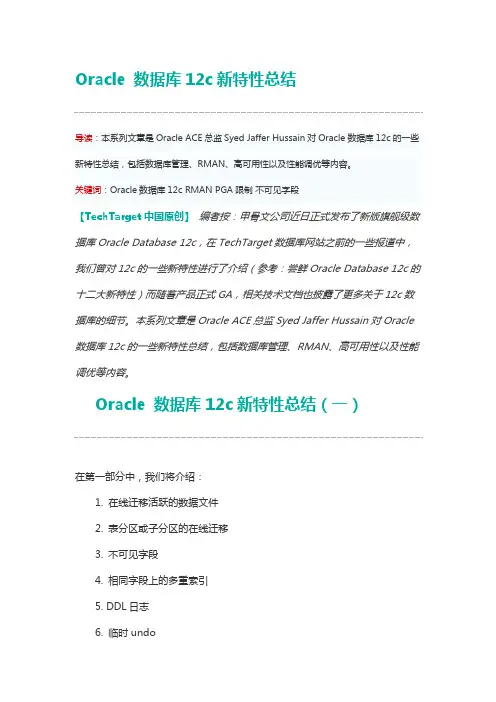
Oracle 数据库12c新特性总结导读:本系列文章是Oracle ACE总监Syed Jaffer Hussain对Oracle数据库12c的一些新特性总结,包括数据库管理、RMAN、高可用性以及性能调优等内容。
关键词:Oracle数据库12c RMAN PGA限制不可见字段【TechTarget中国原创】编者按:甲骨文公司近日正式发布了新版旗舰级数据库Oracle Database 12c,在TechTarget数据库网站之前的一些报道中,我们曾对12c的一些新特性进行了介绍(参考:尝鲜Oracle Database 12c的十二大新特性)而随着产品正式GA,相关技术文档也披露了更多关于12c数据库的细节。
本系列文章是Oracle ACE总监Syed Jaffer Hussain对Oracle 数据库12c的一些新特性总结,包括数据库管理、RMAN、高可用性以及性能调优等内容。
Oracle 数据库12c新特性总结(一)在第一部分中,我们将介绍:1. 在线迁移活跃的数据文件2. 表分区或子分区的在线迁移3. 不可见字段4. 相同字段上的多重索引5. DDL日志6. 临时undo7. 新的备份用户特权8. 如何在RMAN中执行SQL语句9. RMAN中的表级别恢复10. PGA的大小限制问题1. 在线重命名和重新定位活跃数据文件不同于以往的版本,在Oracle数据库12c R1版本中对数据文件的迁移或重命名不再需要太多繁琐的步骤,即把表空间置为只读模式,接下来是对数据文件进行离线操作。
在12c R1中,可以使用ALTER DATABASE MOVE DATAFILE这样的SQL语句对数据文件进行在线重命名和移动。
而当此数据文件正在传输时,终端用户可以执行查询,DML以及DDL方面的任务。
另外,数据文件可以在存储设备间迁移,如从非ASM迁移至ASM,反之亦然。
重命名数据文件:SQL> ALTER DATABASE MOVE DATAFILE '/u00/data/users01.dbf' TO '/u00/data/u sers_01.dbf';从非ASM迁移数据文件至ASM:SQL> ALTER DATABASE MOVE DATAFILE '/u00/data/users_01.dbf' TO '+DG_DATA ';将数据文件从一个ASM磁盘群组迁移至另一个ASM磁盘群组:SQL> ALTER DATABASE MOVE DATAFILE '+DG_DATA/DBNAME/DATAFILE/users_0 1.dbf ' TO '+DG_DATA_02';在数据文件已存在于新路径的情况下,以相同的命名将其覆盖:SQL> ALTER DATABASE MOVE DATAFILE '/u00/data/users_01.dbf' TO '/u00/data_ new/users_01.dbf' REUSE;复制文件到一个新路径,同时在原路径下保留其拷贝:SQL> ALTER DATABASE MOVE DATAFILE '/u00/data/users_01.dbf' TO '/u00/data_ new/users_01.dbf' KEEP;当通过查询v$session_longops动态视图来移动文件时,你可以监控这一过程。
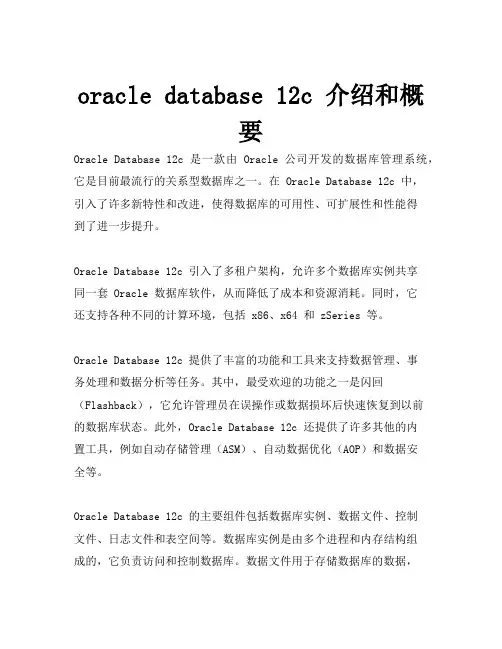
oracle database 12c 介绍和概要Oracle Database 12c 是一款由 Oracle 公司开发的数据库管理系统,它是目前最流行的关系型数据库之一。
在 Oracle Database 12c 中,引入了许多新特性和改进,使得数据库的可用性、可扩展性和性能得到了进一步提升。
Oracle Database 12c 引入了多租户架构,允许多个数据库实例共享同一套 Oracle 数据库软件,从而降低了成本和资源消耗。
同时,它还支持各种不同的计算环境,包括 x86、x64 和 zSeries 等。
Oracle Database 12c 提供了丰富的功能和工具来支持数据管理、事务处理和数据分析等任务。
其中,最受欢迎的功能之一是闪回(Flashback),它允许管理员在误操作或数据损坏后快速恢复到以前的数据库状态。
此外,Oracle Database 12c 还提供了许多其他的内置工具,例如自动存储管理(ASM)、自动数据优化(AOP)和数据安全等。
Oracle Database 12c 的主要组件包括数据库实例、数据文件、控制文件、日志文件和表空间等。
数据库实例是由多个进程和内存结构组成的,它负责访问和控制数据库。
数据文件用于存储数据库的数据,控制文件包含了数据库元数据和磁盘文件的信息,日志文件记录了对数据的所有更改信息。
表空间则是由一个或多个数据文件组成的逻辑容器,用于存储用户的数据。
总之,Oracle Database 12c 是一款功能强大、易于使用和管理的关系型数据库,适用于各种不同的应用场景。
它提供了许多先进的功能和工具,可以帮助企业降低成本、提高性能和可靠性,是数据库管理员的理想选择。
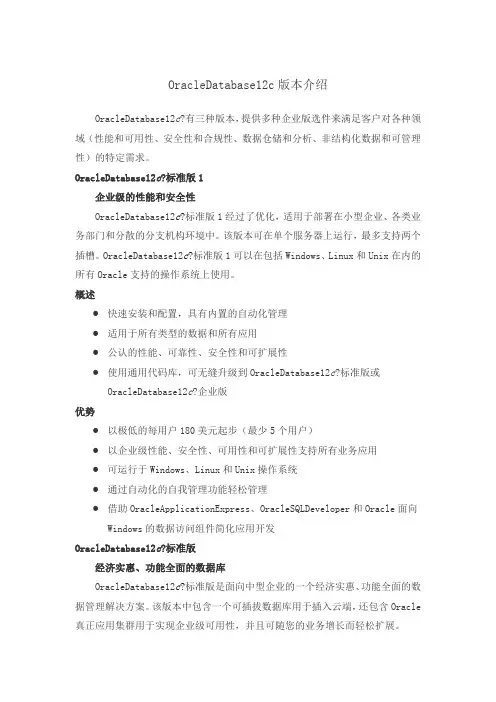
OracleDatabase12c版本介绍OracleDatabase12c?有三种版本,提供多种企业版选件来满足客户对各种领域(性能和可用性、安全性和合规性、数据仓储和分析、非结构化数据和可管理性)的特定需求。
OracleDatabase12c?标准版1企业级的性能和安全性OracleDatabase12c?标准版1经过了优化,适用于部署在小型企业、各类业务部门和分散的分支机构环境中。
该版本可在单个服务器上运行,最多支持两个插槽。
OracleDatabase12c?标准版1可以在包括Windows、Linux和Unix在内的所有Oracle支持的操作系统上使用。
概述●快速安装和配置,具有内置的自动化管理●适用于所有类型的数据和所有应用●公认的性能、可靠性、安全性和可扩展性●使用通用代码库,可无缝升级到OracleDatabase12c?标准版或OracleDatabase12c?企业版优势●以极低的每用户180美元起步(最少5个用户)●以企业级性能、安全性、可用性和可扩展性支持所有业务应用●可运行于Windows、Linux和Unix操作系统●通过自动化的自我管理功能轻松管理●借助OracleApplicationExpress、OracleSQLDeveloper和Oracle面向Windows的数据访问组件简化应用开发OracleDatabase12c?标准版经济实惠、功能全面的数据库OracleDatabase12c?标准版是面向中型企业的一个经济实惠、功能全面的数据管理解决方案。
该版本中包含一个可插拔数据库用于插入云端,还包含Oracle 真正应用集群用于实现企业级可用性,并且可随您的业务增长而轻松扩展。
●支持使用一个可插拔数据库实现入门级云计算和整合●跨平台恢复●内置的Oracle真正应用集群支持更高水平的系统正常运行时间●简化的安装和配置●适用于所有类型的数据和所有应用●向上兼容OracleDatabase12c?企业版,从而保护您的初期投资优势●每用户350美元(最少5个用户),您可以只购买目前需要的许可,然后使用Oracle真正应用集成随需扩展,从而节省成本●提高服务质量,实现企业级性能、安全性和可用性●可运行于Windows、Linux和Unix操作系统●通过自动化的自我管理功能轻松管理●借助OracleApplicationExpress、OracleSQLDeveloper和Oracle面向Windows的数据访问组件简化应用开发OracleDatabase12c?企业版插入云端全球首屈一指的数据库推出最新版本——OracleDatabase12c现已推出,可在各种平台上使用。


串串⾏行行到并⾏行行解读Oracle 12.2的核⼼心新特性孙雪云和恩墨墨•Agility – 敏捷–Rapid provisioning, cloning, movement•Elasticity – 弹性–Scale-out CPU cores, storage, memory•Cloud-scale Operations–Manage many databases as-one •Transforming Data Management–From Disk-based to In-Memory Databases –From Data Warehouse to Big Data–From On-Prem to Database Optimized CloudOracle 12c 的设计理理念转型深度转型速度适应性⾏行行业 重塑型⾏行行业迟钝型⾏行行业互补性⾏行行业Oracle 在12c中做了了什什么⾼高可⽤用⽤用于数据仓库的Data Guard;表的在线迁移和分区DBCA创建standbyIn-Memory IM expressions; Virtual Column;Fast Start;Join groupCore Improvement 实时索引配置情绪分析和搭配提取⽂文档单词的同义词创建只读分区Sharding分⽚片⾃自动部署;⽣生命周期管理理⾃自动管理理智能路路由RAC and GridActiveData GuardBig andData WarehouseMultitenantFlex ASM;Flex ClusterExtended RAC的配置⽀支持远程AWR;ADG⽀支持 SQL tuning advisor基于快照的standby只读实例例,local temp tablespace;并⾏行行递归with的增强SQL执⾏行行计划的增强管理理Application container;Domain based on PDBProxy PDB串串⾏行行的世界说多了了都是泪串串⾏行行到并⾏行行为什什么如此重要企业应⽤用的变化:业务系统增多业务数据量量变⼤大并发访问严重⽽而系统⾯面临的问题:通过CPU主频提升,软件能够⾃自动提升性能的时代已经⼀一去不不复返;⽽而⽤用户对于性能,响应速度要求更更⾼高在⾼高并发系统中,串串⾏行行就是等待⾼高配置⾼高并发⾼高等待阿姆达尔定律律串串⾏行行到并⾏行行,Slave 进程的引⼊入RAC 并⾏行行优化:LMs ! RMVn,CRn 单库并⾏行行优化:LGWR !LGnn 132Dg 并⾏行行优化:Multi MRP单实例例并⾏行行:LGWR! LGnn1、LGWR的作⽤用:2、LGWR相关的等待: Foreground:Log file Sync Background:Log file parallel write3、 Log file Sync产⽣生的原因:commit 过于频繁? Log buffer 过⼤大?CPU负载⾼高?4、什什么时候会产⽣生log file sync等待1)commit操作2)rollback操作3)DDL操作(DDL操作实施前都会⾸首先进⾏行行⼀一次commit)4)DDL操作导致的数据字典修改所产⽣生的commit5)某些能递归修改数据字典的操作:⽐比如查询SEQ的next值,可能会导致修改数据字典。
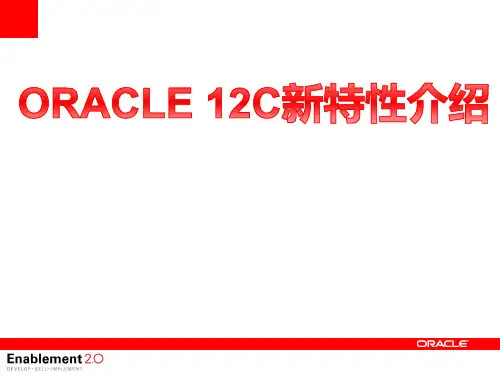
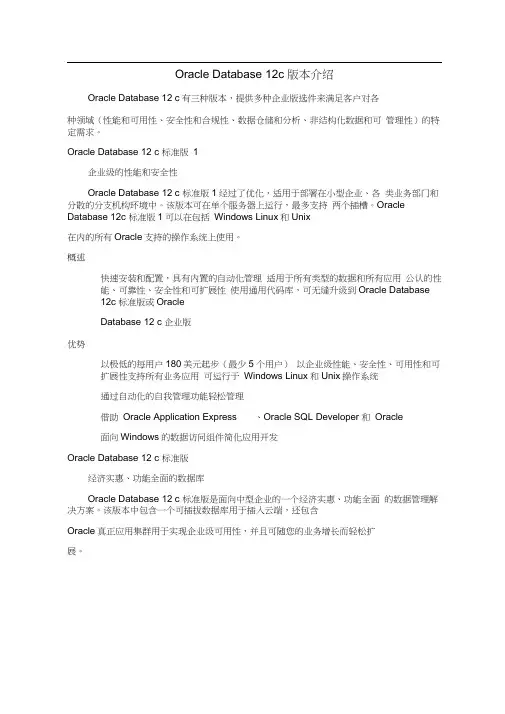
Oracle Database 12c 版本介绍Oracle Database 12 c有三种版本,提供多种企业版选件来满足客户对各种领域(性能和可用性、安全性和合规性、数据仓储和分析、非结构化数据和可管理性)的特定需求。
Oracle Database 12 c 标准版1企业级的性能和安全性Oracle Database 12 c 标准版1经过了优化,适用于部署在小型企业、各类业务部门和分散的分支机构环境中。
该版本可在单个服务器上运行,最多支持两个插槽。
Oracle Database 12c 标准版1可以在包括Windows Linux和Unix在内的所有Oracle支持的操作系统上使用。
概述快速安装和配置,具有内置的自动化管理适用于所有类型的数据和所有应用公认的性能、可靠性、安全性和可扩展性使用通用代码库,可无缝升级到Oracle Database12c 标准版或OracleDatabase 12 c 企业版优势以极低的每用户180美元起步(最少5个用户)以企业级性能、安全性、可用性和可扩展性支持所有业务应用可运行于Windows Linux和Unix操作系统通过自动化的自我管理功能轻松管理借助Oracle Application Express 、Oracle SQL Developer 和Oracle面向Windows的数据访问组件简化应用开发Oracle Database 12 c 标准版经济实惠、功能全面的数据库Oracle Database 12 c 标准版是面向中型企业的一个经济实惠、功能全面的数据管理解决方案。
该版本中包含一个可插拔数据库用于插入云端,还包含Oracle真正应用集群用于实现企业级可用性,并且可随您的业务增长而轻松扩展。
支持使用一个可插拔数据库实现入门级云计算和整合跨平台恢复内置的Oracle真正应用集群支持更高水平的系统正常运行时间简化的安装和配置适用于所有类型的数据和所有应用向上兼容Oracle Database 12 c 企业版,从而保护您的初期投资优势每用户350美元(最少5个用户),您可以只购买目前需要的许可,然后使用Oracle真正应用集成随需扩展,从而节省成本提高服务质量,实现企业级性能、安全性和可用性可运行于Windows Linux和Unix操作系统通过自动化的自我管理功能轻松管理借助Oracle Application Express 、Oracle SQL Developer 和Oracle面向Windows的数据访问组件简化应用开发Oracle Database 12 c 企业版插入云端全球首屈一指的数据库推出最新版本Oracle Database 12 c 现已推出,可在各种平台上使用。
Oracle12c容器讲解Oracle 12c⼀个重要新特性是插接式数据库。
插接式数据库由⼀个使⽤ CDB(Container Database)选项创建的容器数据库和⼀个或多个 PDB(Pluggable Database)组成,CDB 作为容器容纳 PDB,⽽ PDB 彼此隔离,就像⼀个独⽴的数据库般在 CDB 中存在。
PDB 是⼀组 Schema 的集合,在 CDB 中作为⼀个独⽴的组件容器⽽存在。
从这个意义上说,PDB 也是⼀种容器(Container),⽽ CDB 中可以存在多种不同类型的容器。
CDB 的组成① ROOTRoot 是⼀个系统提供的容器,⽤于存储公⽤⽤户,公⽤⽤户可以连接到其他容器,可以查看系统级元数据,这个 Root 容器被命名为CDB$ROOT.② Seed PDB种⼦ PDB 是⼀个系统级模版,CDB 可以⽤这个模版创建其他 PDB,种⼦ PDB 的名称是 PDB$SEED,其中的对象不能被修改。
这其中最为主要的是 SYSTEM 和 SYSAUX 表空间⽂件,这是⼀个种⼦数据库,已经内置了字典对象,如果使⽤模板⽅式建库,PDB 则由此克隆创建出来。
容器 CDB$ROOT 和 PDB$SEED 对于⼀个插接式数据库来说是必须的基本组件,这两者构成了插接式数据库的基础⽀撑。
其关系如下图所⽰:③ PDBPDB 是⽤户基于特定需求建⽴的对象容器,在创建 CDB 时,可以不同时创建 PDB,PDB 随后可以根据⽤户的需求创⽴。
插接式数据库的主要特性:可以通过现有数据库快速配置和部署新的环境;通过 unplug 和 plug 可以快速进⾏数据库迁移和整合;集中的部署可以加快升级迁移的过程,缩减维护成本;⽅便的整合和拆分⽅式便于集中部署或在压⼒过⼤时迅速拆分部署;分离管理员的职责,强化安全管理;在 CDB 的模式下,由于 PDB 具有独⽴的 SYSTEM 和 SYSAUX 表空间,其元数据和系统元数据⾃然分离,⽤户数据的字典信息也就⽆需再记录到系统的元数据中,这对于核⼼的元数据是⼀种更好的隔离和保护,下图描述了在 CDB、PDB 模式下⽤户数据和元数据的分离关系,其中数据字典元数据也就是 Root Container:各个容器都有⼀个标识(CON_ID),其中CDB实例的ID为0,CDB$ROOT 的ID为1,PDB$SEED的ID为2,pdb从3开始分配。
Program AgendaWindows Platform Support Oracle Database 12c Release 2Cloud123Windows Platform SupportWindows Server 2016 and Windows 10 Supported Editions•Windows Server 2016 editions–Datacenter, Essentials, and Standard Edition •Windows 10 editions–Education, Enterprise, and ProDatabase Certification on 32-bit WindowsOS11.2 DB and client112.1 client2 Windows 7Yes Yes Windows Server 2008Yes Yes Windows Server 2008 R2Yes Yes Windows 811.2.0.4Yes Windows 8.111.2.0.412.1.0.2 Windows Server 201211.2.0.4 Yes Windows 10No12.1.0.2#1RAC 11.2 and higher does not support for 32-bit Windows#2For 12.1 and higher, only DB Client supports 32-bit WindowsNote: Oracle Database Client 12.2 and higher will only support Windows x64.Database Certification on 64-bit WindowsOS11.212.1 12.2 Windows 71Yes Yes Yes Windows Server 2008Yes Yes No Windows Server 2008 R2 Yes Yes No Windows 8111.2.0.4Yes Yes Windows 8.1111.2.0.4 12.1.0.2 Yes Windows Server 201211.2.0.412.1.0.2Yes Windows Server 2012 R211.2.0.412.1.0.2Yes Windows 101No12.1.0.2Yes Windows Server 2016No No Yes2 Note: 32-bit Oracle Client is supported on Windows x64#1RAC and some server features not supported on Windows clients#2To be certified shortly post-releaseDatabase Certification on Windows Hyper-VGuest OS11.212.112.2 Windows Server 2008 R211.2.0.4 (SI only)12.1.0.2 (SI only) No Windows Server 201211.2.0.4 (SI and RAC)12.1.0.x (SI only) 12.2 (SI and RAC) Windows Server 2012 R211.2.0.4 (SI and RAC)12.1.0.2 (SI and RAC)12.2 (SI and RAC) (Generation 1)Windows Server 2012 R2No12.1.0.2 (SI and RAC)12.2 (SI and RAC) (Generation 2)•Host OS: Microsoft Hyper-V Server 2012 and 2012 R2 are certified •Host OS: Microsoft Hyper-V Server 2016 will be certifiedOracle Database 12c Release 2 SecuritySecurity•Oracle Home User•Windows Native Authentication •Kerberos and ASM enhancementsOracle Home User Support•Run Windows Services for Oracle using a standard Windows account •Specify a standard (not an administrator) Windows User Account as Oracle Home User during install and upgradeMicrosoft Windows User Types Overview Built-inAccountLocalSystem (Full Administrator Privileges)LocalService(Minimumprivileges)User AccountAdministrator(Local orDomain user)Standard User(Local orDomain User)ManagedService Acct(Domain User)•Account needs to be associated withspecific computer system (s)•No password management needed onlocal hosts•No need to provide passwords duringWindows service configurationVirtual Account(for WindowsService)New Windows User Account Types Supported•Virtual Account–Introduced by Microsoft in Windows 7 and Windows Server 2008 R2–Each Windows Service has it’s own virtual account name–No password management–Can work in a workgroup or domain–Ability to access the network with a computer identity in a domain environment •Group Managed Service Account (gMSA)–Introduced by Microsoft in Windows Server 2012–Single Group Managed Service Account (gMSA) can be used on multiple hosts –No password management needed on local hosts–No need to provide passwords during Windows service configurationOracle Database Server InstallOracle Home User•Different from Oracle Installation User who must have OS administration privileges•Services for the Oracle Home run with this user name•Can be Windows Built-in Account or Virtual Account or a standard Windows User Account•Can not be changed post install•Have similarities with ‘oracle’ user on Linux, though you can not log in as the Oracle Home User on Windows and perform administration tasks (e.g. Create DB, Install, Upgrade)Virtual Account Support•New default for Single Instance Oracle Database Server install•Only supported for Single Instance Oracle Database Server install •No need to manage user name or password for Oracle Home User •Database files are owned by the virtual account for the Oracle Database Windows Service (e.g. NT Service\OracleServiceORCL) •Note: DB Client, built-in account option, uses LocalService and Service SIDs for client side Windows services, and is very similar to how Virtual Account worksGroup Managed Service Account support•Supported for all Oracle Database installs (DB Client, Single Instance Oracle Database, RAC and Grid Infrastructure)•Works like any other domain user but no need to create Oracle wallet and/or provide password for any database operationOracle RAC Database InstallOracle Grid Infrastructure InstallDatabase Client Install•For Built-in Accountoption, WindowsServices run underLocalService (notLocalSystem) forDatabase ClientInstallWindows Account option for Oracle Home User Needs to bepre-created?Password neededduring DBoperations?DBServer(SI)DBClientDBServer(RAC)GridInfra-structureVirtual Account N N Y N N N Built-in Account (internally, useLocalSystem)N N Y N Y YBuilt-in Account (internally, useLocalService)#2N N N Y N N Local User Account#2N Y Y#1Y N N Managed Services Account Y N Y Y N N Group Managed Services Account Y N Y Y Y Y Domain Account Y Y Y Y Y Y#1 –Windows OS authentication can not be used across systems#2 –Windows Services can not access any secure shared network resource using its own Windows identity`Oracle Database Services on WindowsOracle ListenerServiceDatabasesOracle DatabaseServiceORACLE BASEORACLE HOMEOther FilesWindows ServicesFile System ACLs•Services run as a Windows User (e.g. domain1\frank)•Each service also has a unique Service SID (e.g. Database sid orcl has service SID: NTAUTHORITY\OracleServiceORCL)•Either user name or Service SID can be used to grant privileges or set ACLs for file system access•Oracle sets appropriate ACLs for Oracle Home and Oracle Base•For customer specific files/directories in non-standard locations, ACLs may need to be changed to make them accessible to Oracle ServicesPlease check Oracle Database Platform Guide for Microsoft Windows for more information.Database Creation•Database Configuration Assistant (DBCA) is used to create or modify Oracle Database as a part of install or as post install action •Administrator, invoking the tools, needs to be an OS Administrator and should have appropriate database privileges•Use the icon Database Configuration Assistant(the icon is set up to “run as administrator”) to invoke DBCA•As Windows Service creation requires both user id and password, DBCA will ask for the password of Oracle Home User (if needed) in order to create the Windows Service•For Single Instance DB, password is needed for Windows Local User and Domain User•For RAC, the customer has the option to store password in wallet; if not stored, the password needs to be input for Windows Domain UserDatabase 1 (12c)Database 1 (11.2)Oracle Database UpgradeORACLE_BASEORADATAORACLE_HOME (11.2)Database 2 (11.2)ORACLE_BASEORADATAORACLE_HOME (11.2)Database 2 (11.2)ORACLE_HOME (12c)Oracle Home and Database Upgrade•Database Upgrade Assistant (DBUA) is used for database upgrade across Oracle Homes as a part of install or as post install action •Administrator, invoking the tools, needs to be an OS Administrator and should have appropriate database privileges•Use the icon Database Upgrade Assistant (the icon is set up to “run as administrator”)•Requirement to enter Oracle Home User and Password is similar to Database creation•When a database is upgraded, it will ask for password of Oracle HomeUser (if needed)Administration Tools•All GUI tools (e.g. DBCA, NETCA) enhanced to support Oracle Home User and ask for password if needed•All command line tools (e.g. ORADIM, LSNRCTL, CMCTL) enhanced to accept Oracle Home User name and password through stdin for service creation•Silent Install and Cloning enhanced to support Oracle Home User •CRSCTL can be used to create wallet for storing password of Oracle Home User (RAC environment)•Enterprise Manager support of Oracle Home User for provisioning, patching, and service creationManagement of Oracle Home User•As it is a standard Windows user, Windows tools can be used to manage the Windows account (e.g. add privileges, change password)•For changing password of the Oracle Home User account–Use Windows tools to change the password–Windows also requires all Windows Services to be updated to use the new password –For all Windows Services used by Oracle, you can use the icon Update Password for Oracle Home User to:•update password for all Windows services used by Oracle on a computer (Single Instance Database or Client)•change password in Oracle wallet and update password for all Windows services used by Oracle ina cluster (for RAC)You can also use the tool Oracle Home User Control (orahomeuserctl) in command line (run as administrator)Recommendations for Oracle Home User•For DB server (SI)–Use Virtual Account to avoid password management (12.2)–For 12.1, specify a Windows user account during install•For RAC DB and Grid Infrastructure install–Use a domain user or group managed service account–For a group managed service account (12.2), you do not need to provide the password for any database operation•If you want to separate out administration domains (e.g. Production and Test databases) of different Oracle Homes for security reasons:–Use Virtual Account and specify distinct Oracle Base directory for each administration domain –Use distinct Oracle Home User account (and Oracle Base directory) for each administration domain •For DB client install, use Built-in Account optionSecurity•Oracle Home User•Windows Native Authentication •Kerberos and ASM enhancementsWindows Native Authentication (NTS)•Enabled by default and can work across Windows systems•Windows user logon credentials used for database authentication •Windows Explorer or Oracle Administration Assistant can be used to manage user authentication and role authorization•Works for Pluggable Databases•New client-side parameter in sqlnet.ora:–"no_ntlm“, which may be set to true for security reasons. (Only works for domain users) –Examples: CONNECT / AS SYSDBA or CONNECT /Windows Native AuthenticationSYSDBA and SYSOPER Privileges•ORA_DBA–SYSDBA privileges for all Oracle Databases on the system •ORA_OPER–SYSOPER privileges for all Oracle Databases on the system •ORA_<HomeName>_DBA (12cR1)–SYSDBA privileges for Oracle Databases on a specific Oracle Home •ORA_<HomeName>_OPER (12cR1)–SYSOPER privileges for Oracle Databases on a specific Oracle HomeAll the groups are on the server systemWindows Native AuthenticationSeparation of Privileges•ORA_<HomeName>_ SYSBACKUP (12cR1)–Backup privileges (SYSBACKUP) for databases of a specific Oracle Home •ORA_<HomeName>_SYSDG (12cR1)–Data Guard Privileges (SYSDG) for databases of a specific Oracle Home•ORA_<HomeName>_ SYSKM (12cR1)–Encryption Key Management privileges (SYSKM) for databases of a specific Oracle HomeAll the groups are on the server systemWindows Native Authentication•ORA_ASMADMIN (12cR1)–SYSASM administration privileges on the computer•ORA_ASMDBA (12cR1)–SYSDBA privileges for ASM Instance on the computer•ORA_ASMOPER (12cR1)–SYSOPER privileges for ASM Instance on the computer•ORA_DBA and ORA_OPER group members no longer get privileges for ASM instance Administrative Privileges for ASM InstanceAll the groups are on the server systemSecurity•Oracle Home User•Windows Native Authentication •Kerberos and ASM enhancementsKerberos and ASM Enhancements•Kerberos–Security enhancements that were introduced in the MIT Kerberos Release 1.8 distribution–In sqlnet.ora, setSQLNET.KERBEROS5_CC_NAME = MSLSA: (instead of OSMSFT:)•ASM file access control–Restrict access of database files to the owner of the database homeOracle Database 12c Release 2 Scalability and PerformanceLarge Pages•Improve performance with large pages support–2 MB Page size (instead of 4 KB)•If Oracle Home User is a standard Windows account, administrator must grant the "Lock pages in memory" privilege to Oracle Home User or Service SID of Oracle Database Service (NTAUTHORITY\OracleService<sid>)Large Pages•Under HKEY_LOCAL_MACHINE\SOFTWARE\ORACLE\KEY_HOMENAME–Create ORA_LPENABLE or ORA_SID_LPENABLE–Set the value to 1 for regular mode and 2 for mixed mode–Mixed mode is the new option to allow use of large pages but fall back to small pages if OS is not able to allocate large pages–ORA_SID_LPMAXTIME is the optional time parameter for mixed mode•If a server has been running for some time and memory is fragmented, OS may fail to allocate large pages–Mixed mode can be used to ensure that DB comes up in such casesMultiple Processor Groups•Support max of 10 processor groups with up to 64 CPUs in each group in 12.1.0.2 (12.1.0.1 supports 4 processor groups)•ORACLE_AFFINITY enhanced to enable affinity of Oracle threads to CPUs in multiple processor groups–processorgroup is an optional parameter designating Windows CPU group •On systems with 64+ logical CPUs, Windows divides all available CPUs into 4 groups (0,1,2,3) with each group containing no more than 64 logical CPUs•Details in Oracle Database Platform Guide for Microsoft WindowsDNFS Client and Resilient File System•Database 12c DNFS client–Standard NFS path formats allow user to utilize standard URN notation for NFS in oranfstab config file and while working with oradnfs utility•e.g.“nfs://server/share/file”•Windows Resilient File System supportOracle Database 12c Release 2 Ease of Management and DevelopmentOracle Database Instance Manager Available as Microsoft Management Console Snap-InORADIM as an MMC Snap-In•ORADIM performs DB create, edit, delete, start, and shutdown operations •All ORADIM operations available in snap-in•Benefits–Centralized instance management for all Oracle Database Homes–Familiar Windows GUI management tool•Found in path ORACLE_HOME\MMC Snap-Ins\oradim or click on ORADIM shortcut in Oracle Home.NET DevelopmentODAC•DB Client 12.2–Application Continuity–Sharding•ODAC 12.2–Connection pool tagging– Database Resident Connection Pooling (DRCP)–Oracle Multitenant improvements–Oracle Edition-Based Redefinition improvements–Offline Schema Compare in Visual StudioCloud Windows and .NETOracle Compute Cloud ServiceDeploy .NET applications to Oracle IaaS on Windows •Windows 2012 R2and Windows 2008 R2VMs available from Oracle Cloud Marketplace to–Free during promotional period–Deploy to Oracle Compute•Deploy and configure IIS, .NET, and apps to Oracle Compute–How To White Paper: Deploying Microsoft Web ApplicationServer on Oracle Compute Cloud ServiceDevelopment & Test Easy On-Ramp to Oracle Database Cloud Services Dedicated Exadata Full-Instance Enterprise ExadataExpressHighest Availability, Scalability, Performance SMB, Departmental ApplicationsEnterprise ApplicationsThe Best Cloud Database for Windows Developers •Popular language drivers–•Multiple interfaces–Full Oracle Net (SQL*Net)–REST API, JSON storage •Updated tools–Oracle Developer Tools for VS –SQL Developer, Data Modeler –Powerful new command-lineDATABASE12cR2Oracle APEXOracle SQLDeveloperOracle Database Exadata Express Cloud Service Connect from On-premises•Use and ODT 12.1 for Oracle Public Cloud or higher –ODT for VS 2015 and VS 2013–Managed and unmanaged •How to connect:–Developing .NET Applications for Oracle Database Exadata Express Cloud Service–Uses Oracle Net Services with Oracle Wallet to secure connectionOracle Database Cloud Service (non-Exadata Express) Connect from On-premises•Use and ODT 12.1 for Oracle Public Cloud or higher–ODT for VS 2015 and VS 2013–Managed and unmanaged •How to connect:–Developing .NET Applications for Oracle Database as a Service–Secure Shell (SSH) required to secure connection•Use SSH client to create tunnel, such as PuTTY•PuTTY can also generate private and public SSH key pairQ&A。
Oracle 数据库12c新特性总结导读:本系列文章是Oracle ACE总监Syed Jaffer Hussain对Oracle数据库12c的一些新特性总结,包括数据库管理、RMAN、高可用性以及性能调优等内容。
关键词:Oracle数据库12c RMAN PGA限制不可见字段【TechTarget中国原创】编者按:甲骨文公司近日正式发布了新版旗舰级数据库Oracle Database 12c,在TechTarget数据库网站之前的一些报道中,我们曾对12c的一些新特性进行了介绍(参考:尝鲜Oracle Database 12c的十二大新特性)而随着产品正式GA,相关技术文档也披露了更多关于12c数据库的细节。
本系列文章是Oracle ACE总监Syed Jaffer Hussain对Oracle 数据库12c的一些新特性总结,包括数据库管理、RMAN、高可用性以及性能调优等内容。
Oracle 数据库12c新特性总结(一)在第一部分中,我们将介绍:1. 在线迁移活跃的数据文件2. 表分区或子分区的在线迁移3. 不可见字段4. 相同字段上的多重索引5. DDL日志6. 临时undo7. 新的备份用户特权8. 如何在RMAN中执行SQL语句9. RMAN中的表级别恢复10. PGA的大小限制问题1. 在线重命名和重新定位活跃数据文件不同于以往的版本,在Oracle数据库12c R1版本中对数据文件的迁移或重命名不再需要太多繁琐的步骤,即把表空间置为只读模式,接下来是对数据文件进行离线操作。
在12c R1中,可以使用ALTER DATABASE MOVE DATAFILE这样的SQL语句对数据文件进行在线重命名和移动。
而当此数据文件正在传输时,终端用户可以执行查询,DML以及DDL方面的任务。
另外,数据文件可以在存储设备间迁移,如从非ASM迁移至ASM,反之亦然。
重命名数据文件:SQL> ALTER DATABASE MOVE DATAFILE '/u00/data/users01.dbf' TO '/u00/data/u sers_01.dbf';从非ASM迁移数据文件至ASM:SQL> ALTER DATABASE MOVE DATAFILE '/u00/data/users_01.dbf' TO '+DG_DATA ';将数据文件从一个ASM磁盘群组迁移至另一个ASM磁盘群组:SQL> ALTER DATABASE MOVE DATAFILE '+DG_DATA/DBNAME/DATAFILE/users_0 1.dbf ' TO '+DG_DATA_02';在数据文件已存在于新路径的情况下,以相同的命名将其覆盖:SQL> ALTER DATABASE MOVE DATAFILE '/u00/data/users_01.dbf' TO '/u00/data_ new/users_01.dbf' REUSE;复制文件到一个新路径,同时在原路径下保留其拷贝:SQL> ALTER DATABASE MOVE DATAFILE '/u00/data/users_01.dbf' TO '/u00/data_ new/users_01.dbf' KEEP;当通过查询v$session_longops动态视图来移动文件时,你可以监控这一过程。
Oracle Database 12c版本介绍Oracle Database 12c有三种版本,提供多种企业版选件来满足客户对各种领域(性能和可用性、安全性和合规性、数据仓储和分析、非结构化数据和可管理性)的特定需求。
Oracle Database 12c标准版1企业级的性能和安全性Oracle Database 12c标准版1经过了优化,适用于部署在小型企业、各类业务部门和分散的分支机构环境中。
该版本可在单个服务器上运行,最多支持两个插槽。
Oracle Database 12c标准版1可以在包括Windows、Linux和Unix 在内的所有Oracle支持的操作系统上使用。
概述●快速安装和配置,具有内置的自动化管理●适用于所有类型的数据和所有应用●公认的性能、可靠性、安全性和可扩展性●使用通用代码库,可无缝升级到Oracle Database 12c标准版或OracleDatabase 12c企业版优势●以极低的每用户180美元起步(最少5个用户)●以企业级性能、安全性、可用性和可扩展性支持所有业务应用●可运行于Windows、Linux和Unix操作系统●通过自动化的自我管理功能轻松管理●借助Oracle Application Express、Oracle SQL Developer和Oracle面向Windows的数据访问组件简化应用开发Oracle Database 12c标准版经济实惠、功能全面的数据库Oracle Database 12c标准版是面向中型企业的一个经济实惠、功能全面的数据管理解决方案。
该版本中包含一个可插拔数据库用于插入云端,还包含Oracle真正应用集群用于实现企业级可用性,并且可随您的业务增长而轻松扩展。
●支持使用一个可插拔数据库实现入门级云计算和整合●跨平台恢复●内置的Oracle真正应用集群支持更高水平的系统正常运行时间●简化的安装和配置●适用于所有类型的数据和所有应用●向上兼容Oracle Database 12c企业版,从而保护您的初期投资优势●每用户350美元(最少5个用户),您可以只购买目前需要的许可,然后使用Oracle真正应用集成随需扩展,从而节省成本●提高服务质量,实现企业级性能、安全性和可用性●可运行于Windows、Linux和Unix操作系统●通过自动化的自我管理功能轻松管理●借助Oracle Application Express、Oracle SQL Developer和Oracle面向Windows的数据访问组件简化应用开发Oracle Database 12c企业版插入云端全球首屈一指的数据库推出最新版本——Oracle Database 12c现已推出,可在各种平台上使用。
ORACLE容器数据库与可插拔数据库⼀、容器数据库与可插拔数据库1、ORACLE MULTITEMENT CONTAINER DATABASE(CDB),即多容器数据库是ORACLE12c新引⼊的特性,这个特性允许CDB容器数据库中创建并且维护多个数据库,在CDB中创建的数据库被称为PDB,每个PDB 在CDB中是独⽴的,在单独使⽤PDB时与普通数据库⽆差别。
CDB根容器数据库的主要作⽤就是容纳所有相关的PDB元数据,以及在CDB 中对虽有PDB进⾏管理。
2、多租户环境组成(1)ROOT:ROOT容器数据库,是CDB环境中的根数据库,在跟数据库中含有主数据字典视图,其中包含了与ROOT容器有关的元数据和CDB中包含的所有PDB信息,在CDB环境中被标识为CDB$ROOT,每个CDB环境中只能有⼀个ROOT容器数据库。
(2)PDB SEED:PDB SEED为PDB的种⼦,其中提供了数据⽂件,在PDB环境中被标识为PDB$SEED,是创建PDB的模板,可以连接PDB$SEED但是不能执⾏任何事务,因为PDB$SEED是只读的,不可修改。
(3)PDBS:PDBS数据库,在CDB环境中每个PDB都是独⽴存在的,与传统ORACLE数据库⽆差别,每个PDB拥有⾃⼰的数据⽂件和OBJECTS,唯⼀的区别就是PDB可以插⼊到PDB中,以及从CDB中拔出。
当⽤户连接到PDB时不会感觉到根容器和其他PDB的存在。
⼆、容器数据库基操1、查看当前数据库下有哪些PDB2、查看当前连接的是哪个数据库3、查看数据⽂件,⽇志⽂件,控制⽂件以及表空间4、切换数据库三、创建⼀个PDB1、因为PDB是由PDBSEED中⽂件创建⽽来,所以要确定PDBSEED⽂件位置。
2、创建PDB⽂件存放⽬录。
3、从PDBSEED创建PDBcreate pluggable database pdb1admin user admin1 identified by oracle roles=(connect)file_name_convert=(‘/u03/app/oracle/oradata/cdborcl/pdbseed/’,’/u03/app/oracle/oradata/cdborcl/pdb1/’);4、启⽤pdb_file_name_convert参数创建PDB(每次创建都要指定)5、打开关闭指定的PDB6、在PDB下创建表空间及业务⽤户。
可插拔数据库与Oracle 12c
王翔
【期刊名称】《程序员》
【年(卷),期】2013(000)002
【摘要】Oracle12c也许会给我们带来各种新气息,但相对细枝末节的调整,架构上的改进影响更为深远。
作为数据库市场关注度最高的产品之一,Oracle12c 的信息发布总给人一种“墙里墙外”的感觉。
厂商站在墙里,用户站在墙外:一方面各种会议和研讨会上Oracle次第发布了一系列看上去很与时俱进的新特性,另一方面它又很少谈及这些新特性的技术细节,总体上让人感觉Oracle12c这个产品更像一个“概念股”。
【总页数】1页(P15-15)
【作者】王翔
【作者单位】不详
【正文语种】中文
【中图分类】TP311.13
【相关文献】
1.部署Oracle 12c集群排障 [J], 高杰欣;
2.具有板载ADC的12C热插拔控制器面市 [J],
3.Oracle 12C RAC可扩展性研究与实现 [J], 袁勇;简岩;孙小林
4.Oracle 12c RAC数据库集群运维宝典 [J], 张松坚
5.Oracle 12C安装实例 [J], 王金国;解宝琦;
因版权原因,仅展示原文概要,查看原文内容请购买。
Oracle 12C引入了CDB与PDB的新特性,在ORACLE 12C数据库引入的多租用户环境(Multitenant Environment)中,允许一个数据库容器(CDB)承载多个可插拔数据库(PDB)。
CDB全称为Container Database,中文翻译为数据库容器,PDB全称为Pluggable Database,即可插拔数据库。
在ORACLE 12C之前,实例与数据库是一对一或多对一关系(RAC):即一个实例只能与一个数据库相关联,数据库可以被多个实例所加载。
而实例与数据库不可能是一对多的关系。
当进入ORACLE 12C后,实例与数据库可以是一对多的关系。
下面是官方文档关于CDB与PDB的关系图。
其实大家如果对SQL SERVER比较熟悉的话,这种CDB与PDB是不是感觉和SQL SERVER的单实例多数据库架构是一回事呢。
像PDB$SEED可以看成是master、msdb等系统数据库,PDBS可以看成用户创建的数据库。
而可插拔的概念与SQL SERVER中的用户数据库的分离、附加其实就是那么一回事。
看来ORACLE也“抄袭”了一把SQL SERVER 的概念,只是改头换面的包装了一番。
CDB组件(Components of a CDB)一个CDB数据库容器包含了下面一些组件:ROOT组件ROOT又叫CDB$ROOT, 存储着ORACLE提供的元数据和Common User,元数据的一个例子是ORACLE提供的PL/SQL包的源代码,Common User 是指在每个容器中都存在的用户。
SEED组件Seed又叫PDB$SEED,这个是你创建PDBS数据库的模板,你不能在Seed中添加或修改一个对象。
一个CDB中有且只能有一个Seed. 这个感念,个人感觉非常类似SQL SERVER中的model数据库。
PDBSCDB中可以有一个或多个PDBS,PDBS向后兼容,可以像以前在数据库中那样操作PDBS,这里指大多数常规操作。
这些组件中的每一个都可以被称为一个容器。
因此,ROOT(根)是一个容器,Seed(种子)是一个容器,每个PDB是一个容器。
每个容器在CDB中都有一个独一无二的的ID和名称。
1)连接到CDB数据库连接到CDB数据库容器非常简单,跟以前连接数据库是一样的[oracle@get-orasvr02 ~]$ sqlplus /as sysdbaSQL*Plus: Release 12.1.0.1.0 Production on Sun Oct 2023:41:362013Copyright (c) 1982, 2013, Oracle. All rights reserved.Connected to an idle instance.SQL>[oracle@get-orasvr02 ~]$ sqlplus sys/password as sysdbaSQL*Plus: Release 12.1.0.1.0 Production on Sun Oct 2023:43:172013Copyright (c) 1982, 2013, Oracle. All rights reserved.Connected to an idle instance.2)查看数据库是否为CDBSQL>select name, decode(cdb, 'YES', 'Multitenant Option enabled', 'Regular 12c Database: ') "Multitenant Option" , open_mode, con_id from v$database;NAME Multitenant Option OPEN_MODE CON_ID--------- ----------------------------- ------------------------------EPPS Multitenant Option enabled READ WRITE 0YES表示该数据库是CDB,如果是NO表示是NO-CDB(普通数据库)3)查看当前容器(Container)3.1SQL> show con_nameCON_NAME------------------------------CDB$ROOTSQL>3.2SQL>select sys_context('userenv', 'con_name') "Container DB" from dual;Container DB----------------------------------------------------CDB$ROOTSQL>4)查看CDB容器中的PDBS信息查看CDB中有多少个pluggable databaseSQL>select con_id, dbid, guid, name , open_mode from v$pdbs;CON_ID DBID GUID NAMEOPEN_MODE---------- ---------- -------------------------------------------------------------- ----------24071321146 E89E8DA2866E3157E043DE07A8C09238 PDB$SEED READ ONLY31930201447 E89E9418B882350CE043DE07A8C092B6 PDBEPPS MOUNTEDSQL>5)启动PDB数据库方式1:SQL>alter pluggable database PDBEPPS open;Pluggable database altered.SQL>select con_id, dbid, guid, name , open_mode from v$pdbs;CON_ID DBID GUID NAMEOPEN_MODE---------- ---------- -------------------------------------------------------------- ----------24071321146 E89E8DA2866E3157E043DE07A8C09238 PDB$SEED READ ONLY31930201447 E89E9418B882350CE043DE07A8C092B6 PDBEPPS READ WRITE方式2:SQL>alter session set container=PDBEPPS;Session altered.SQL> startupPluggable Database opened.SQL>6)关闭PDB数据库SQL> alter pluggable database PDBEPPS close;Pluggable database altered.SQL> select con_id, dbid, guid, name , open_mode from v$pdbs;CON_ID DBID GUID NAME OPEN_MODE ---------- ---------- -------------------------------- ------------------------------ ----------2 4071321146 E89E8DA2866E3157E043DE07A8C09238PDB$SEED READ ONLY3 1930201447 E89E9418B882350CE043DE07A8C092B6PDBEPPS MOUNTEDSQL>7)在容器间切换SQL> alter session set container=PDBEPPS;Session altered.SQL> show con_name;CON_NAME------------------------------PDBEPPSSQL>SQL> alter session set container=CDB$ROOT;Session altered.SQL> show con_name;CON_NAME------------------------------CDB$ROOTSQL>Oracle 12C加入了一个非常有新意的功能“可插拔数据库”特性,实现了数据库(PDB)在“容器”(CDB)上的拔功能,既能提高系统资源的利用率,也简化大面积数据库的管理和迁移工作。
下面我们体验一下可插拔数据库的CDB和PDB的操作:基本信息:根容器(CDB):CUP可插拔数据库(PDB):TEA启动根容器:[oracle@eric ~]$ export ORACLE_SID=cup[oracle@eric ~]$ sqlplus / as sysdbaSQL*Plus: Release 12.1.0.2.0 Production on Wed Jan 21 16:00:06 2015Copyright (c) 1982, 2014, Oracle. All rights reserved.Connected to an idle instance.SQL>startup-----不会直接启动所有可插拔数据库,如需启动所有可插拔数据库,执行命令:alter pluggable database all openORACLE instance started.Total System Global Area 767557632 bytesFixed Size 2929112 bytesVariable Size 574623272 bytesDatabase Buffers 184549376 bytesRedo Buffers 5455872 bytesDatabase mounted.Database opened.停止根容器:SQL> shutdown immediateDatabase closed.Database dismounted.ORACLE instance shut down.查看是否创建了CDB,如果有显示名字:SQL> select name,cdb from v$database;NAME CDB--------- ---CUP YESSQL>show parameter service;NAME TYPE VALUE------------------------------------ ----------- ------------------------------ service_names string cup查看容器名字,其中有3个容器:根容器、种子容器和自己创建的容器:SQL> select con_id,name from v$containers;CON_ID NAME---------- ------------------------------1 CDB$ROOT ---根容器2 PDB$SEED ---种子容器,只可读3 TEA ---自己创建的可插拔数据库SQL>select file_name from dba_data_files;FILE_NAME--------------------------------------------------------------------------------/oracle/app/oradata/CUP/datafile/o1_mf_system_bch07kvz_.dbf/oracle/app/oradata/CUP/datafile/o1_mf_sysaux_bch020oo_.dbf/oracle/app/oradata/CUP/datafile/o1_mf_undotbs1_bch0d2on_.dbf/oracle/app/oradata/CUP/datafile/o1_mf_users_bch0d15n_.dbfSQL>select file_name from cdb_data_files;FILE_NAME--------------------------------------------------------------------------------/oracle/app/oradata/CUP/datafile/o1_mf_system_bch07kvz_.dbf/oracle/app/oradata/CUP/datafile/o1_mf_sysaux_bch020oo_.dbf/oracle/app/oradata/CUP/datafile/o1_mf_undotbs1_bch0d2on_.dbf/oracle/app/oradata/CUP/datafile/o1_mf_users_bch0d15n_.dbf创建公共用户:SQL>create user c##eric identified by gao;User created.SQL> conn c##eric/gaoERROR:ORA-01045: user C##ERIC lacks CREATE SESSION privilege; logon denied ----没有权限,我们可以单独给其赋予权限,也可以给其指定角色。